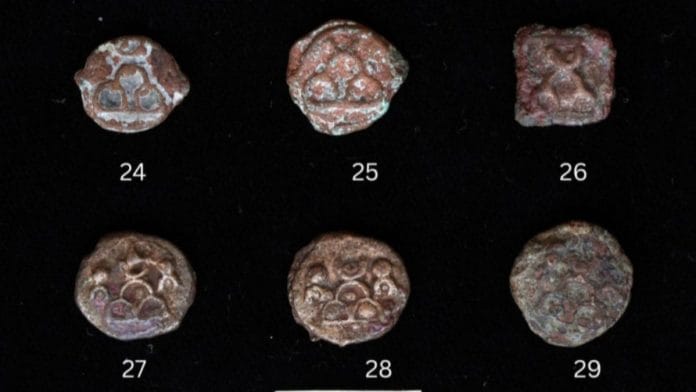New Delhi: Bahaj, an excavation site in a small hamlet of Rajasthan’s Bharatpur, has pushed back the antiquity of coinage in India to the 7th-8th century BCE, according to a recent paper by archaeologist Vinay Gupta. The new research changes the historiography of the coinage in India and has revealed several historical insights.
This means India may have started using coins two to three centuries earlier than we thought. Earlier, the oldest coins dated back to the 4th-5th century BCE.
A superintendent archaeologist (SA) at the Archaeological Survey of India (ASI) Jaipur circle, Gupta’s recent paper titled ‘The Earliest Coinage of Bharat as Unearthed from Bahaj Excavations’ throws new light on the coinage in India. It suggests that the site existed during the late phase of the pre-Mauryan period and that trade and commerce were prevalent in the region.
“For numismatic studies, the site has provided a significant number of coins which include silver punch-marked, copper punch-marked and uninscribed copper cast coins that have been found in the lowest deposits of the site taking back the antiquity of coinage in India to somewhat seventh-eighth century BCE,” reads the paper.
The Bahaj site in Bharatpur bordering Uttar Pradesh was excavated for two seasons by Gupta to untangle the historical threads of the Braj region, the birthplace of the Hindu deity Krishna.
“Coins from the pre-Mauryan period to the late Kushan period have been recovered here, highlighting the site’s historic significance and importance,” reads the paper.
According to the paper, the most striking outcome of the Bahaj numismatic study is the early chronology of the silver and copper punch-marked coins.
Gupta’s team found some coins at a depth of 320 cm and the coins found are defaced. It belongs to circa 450-550 BCE.
“It is plausible that they were in circulation for at least a hundred to two hundred years. Its antiquity can go back to the seventh-eighth century BCE,” reads the paper.
Also read: Three phases, one struggle—CJI Gavai maps Indian judiciary’s uneven journey and blind spots
Ritualistic usage of coins
At Bahaj, Gupta’s team unearthed 220 coins and 47 cowries from various levels of the trenches. Due to excessive soiling and patination on the coins, most of them appeared obscure.
Gupta studied 101 coins and identified them as silver punch-marked coins, copper punch-marked coins, uninscribed copper cast coins, inscribed copper coins, Kshatrapa and Kushan coins.
According to the paper, the coins of Bahaj were used for ritual purposes even by the pre-Mauryan people. In one of the trenches, four coins were wrapped in a cloth piece kept inside a miniature pot, which was offered in a ritualistic pit (Yajnakunda) filled with natural sand.
The ritualistic pits were one of the important finds of the Bahaj excavation. “We found them lined up at the pre-Mauryan level, and they could be an estimated 2,300 years old. It indicates some ritualistic activity. We also found coins, some of which are wrapped in cloth,” said Gupta in 2024.
The Bahaj emerged as a significant site in Indian archaeology. Earlier, the site also revealed that the Brahmi script can be dated back to the time of the painted grey ware (PGW) culture and suggests that the script existed in India way before the Ashoka edicts.
During excavation, hoards were recovered, which revealed that the people of Bahaj kept their money in small pots to preserve it.
The researcher also found cowries, which means that during the Kushana period (1st-3rd century CE), people were using them for transactions along with coins.
“Cowries are often ignored during excavations, but their discovery provides information about the currency system of that time,” according to the paper.
(Edited by Ratan Priya)






